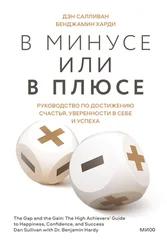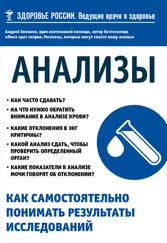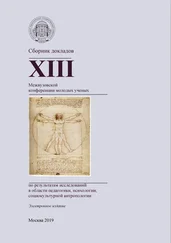14. Bright J.E., Pryor R.G.L., Harpham L. The role of chance events in career decision making // Journal of Vocational Behavior , № 66, 2005, pp.561–576
15. Schneider L. Life decisions & career paths – Leave it all to chance? // Huffington Post , October 7, 2009. В своей статье Шнайдер цитирует Коллин Сейферт, профессора психологии Мичиганского университета и специалиста по предиктивному кодированию. Более подробно об этом феномене см.: Seifert C., Patalano A.L. Opportunism in memory: Preparing for chance encounters // Current Directions in Psychological Science , № 10, 2001, pp.198–201
16. Seligman M.E.P., Steen T.A., Park N., Peterson C. Positive psychology progress: Empirical validation of interventions // American Psychologist , № 60, 2005, pp.410–421
17. Burton C., King L. The health benefits of writing about intensely positive experiences // Journal of Research in Personality , № 38, 2004, pp.150–16318. Taylor S.E. Positive Illusions – New York: Basic books, 1988
Принцип 4. Падай и расти
1. Collins J. How the Mighty Fall – New York: HarperCollins, 2009, p.120
2. Обзор списка см. в публикации: Linley P.A., Joseph S. Positive change following trauma and adversity: A review // Journal of Traumatic Stress , № 17(1), 2004, pp.11–21. Далее в скобках перечислены авторы исследований по каждому из пунктов списка: тяжелая утрата (Davis, Nolen-Hoeksema, Larson – 1998); трансплантация костного мозга (Fromm, Andrykowsky, Hunt – 1996); рак молочной железы (Cordova, Cunningham, Carlson, Andrykowsky – 2001; Weiss – 2002); хронические заболевания (Abraido-Lanza, Guier, Colon – 1998); сердечный приступ (Affleck, Tennen, Croog, Levine – 1987); военные действия (Fontana, Rosenheck – 1998; Schnurr, Rosenberg, Friedman – 1993); стихийное бедствие (McMillen, Smith, Fisher – 1997); физическое нападение (Snape – 1997); вынужденное переселение из-за войны (Powell, Rosner, Butollo, Tedeschi, Calhoun – 2003).
3. Tedeschi R.G., Calhoun L.G., Cann A. Evaluating resource gain: Understanding and misunderstanding posttraumatic growth // Applied Psychology: An International Review , № 56 (3), 2007, pp.396–406 – p. 396
4. Val E.B., Linley P.A. Posttraumatic growth, positive changes and negative changes in Madrid residents following the March, 11, 2004, Madrid train bombings // Journal of Loss and Trauma , № 11, 2006, pp.409–424
5. Weiss T. Posttraumatic growth in women with breast cancer and their husbands: An intersubjective validation study // Journal of Psychosocial Oncology , № 20, 2002, pp.65–80
6. Linley P.A., Joseph S. Positive change following trauma and adversity: A review // Journal of Traumatic Stress , № 17(1), 2004, pp.11–21
7. Val E.B., Linley P.A. Posttraumatic growth, positive changes and negative changes in Madrid residents following the March, 11, 2004, Madrid train bombings // Journal of Loss and Trauma , № 11, 2006, pp.409–424 – p.410
8. Walsh F. Bouncing forward: Resilence in the aftermath of September 11 // Family Processes , № 41, 2002, pp.34–36 – p.35
9. McGregor J. How failure breeds success // Business Week , July 10, 2006. Выбранный мною подзаголовок «Эврика, все пропало!» – цитата из указанного выпуска BusinessWeek. Этот заголовок был опубликован на обложке журнала.
10. Schoemaker P.J.H., Gunther R.E. Wisdom of deliberate mistakes // Harward Business Review , June 2006
11. Ben-Shahar T. The Pursuit of Perfect – New York: McGraw-Hill, p.22
12. Lorenzet S.J., Salas E., Tannenbaum S.I. Benefiting from mistakes: The impact of guided errors on learning, performance, and self-efficacy // Human Resource Development Quaterly , № 16, 2005, pp.301–322
13. Seligman M.E.P. Learned Optimism – New York: Knopf, 1991, pp.19–21
14. Hiroto D.S. Locus of control and learned helplessness // Journal of Experimental Psychology , № 102, 1974, pp.187–193
15. Так описал это Мартин Селигман в своей книге Learned Optimism – New York: Knopf, 1991, p.29
16. Dickler J. Wall St.casualties: Where are they now? // CNN, October 9, 2009; www.cnn.com
17. Recession Benefits // Time Magazine , June 9, 1958
18. Там же
19. Chakravorti B. How to innovate in a downturn // The Wall Street Journal , March 18, 2009
20. Ричард Вайзман – вероятно, самый активный сторонник данной стратегии – он называет ее «контрфактическим мышлением». Более подробную информацию об этой стратегии и способах ее применения см. в его книге: Wiseman R. The Luck Factor – New York: Miramax, 2003
21. Stefanucci J.K., Proffitt D.R., Clore G.L., Parekh N. Skating down a steeper slope: Fear influences the perception of geographical slant // Perception , № 37, 2008, pp.321–323
22. Вся история с компанией MetLife подробно описана в книге Мартина Селигмана Learned Optimism – New York: Knopf, 1991, pp.97–106
23. См., например: Peterson C., Barrett L.C. Explanatory style and academic performance among university freshmen // Journal of Personality and Social Psychology , № 53, 1987, pp.603–607; Nolen-Hoeksema S., Girgus J., Seligman M.E.P. Learned helplessness in children: A longitudinal study of depression, achievement, and explanatory style // Journal of Personality and Social Psychology , № 51, 1986, pp.435–442; Seligman M.E.P., Schulman P. Explanatory style as a predictor of productivity and quitting among life insurance sales agents // Journal of Personality and Social Psychology , № 50, 1986, pp.832–838
24. Seligman M.E.P. Learned Optimism – New York: Knopf, 1991, pp. 152–153
25. Seligman M.E.P, Nolen-Hoeksema S., Thornton N., Thornton K.M. Explanatory style as a mechanism of disappointing athletic performance // Psychological Science , № 1, 1990, pp.143–146. Более подробно о влиянии объяснительного стиля на спортивные результаты см.: Seligman M.E.P. Learned Optimism , pp. 155–166
26. Scheier M.F. et al. Dispositional optimism and recovery from coronary artery bypass surgery: The beneficial effects on physical and psychological well-being // Journal of Personality and Social Psychology , № 57, 1989, pp.1024–1040
27. Модель ABCD имеет долгую и насыщенную историю. Впервые она была упомянута Альбертом Эллиосом, отцом-основателем когнитивной терапии; затем подхвачена Мартином Селигманом (см. его книги Learned Optimism и Authentic Happiness ). Кроме того, эту модель активно использовали Карен Рейвич и Эндрю Шатте в своей замечательной книге «Фактор устойчивости» ( The Resilience Factor ).
Читать дальше
Конец ознакомительного отрывка
Купить книгу












